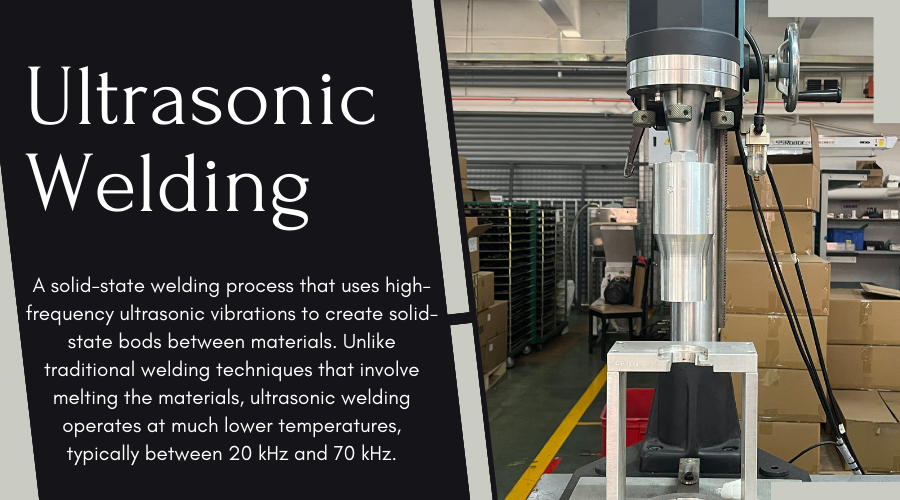In the realm of industrial manufacturing, efficiency, precision, and reliability are paramount. As industries evolve and demand more intricate and durable products, innovative techniques emerge to meet these requirements. One such groundbreaking method is ultrasonic welding, a process that transformed the way materials are joined together. In this article, we delve into the working principle, applications, and the advantages of ultrasonic welding.

Understanding Ultrasonic Welding
Ultrasonic welding is a solid-state welding process that uses high-frequency ultrasonic vibrations to create solid-state bods between materials. Unlike traditional welding techniques that involve melting the materials, ultrasonic welding operates at much lower temperatures, typically between 20 kHz and 70 kHz.
The process involve the following steps:
- Preparation: The materials to be joined are placed in a fixture or clamped together under pressure.
- Vibration: An ultrasonic transducer converts electrical energy into mechanical vibrations at a high frequency. These vibrations are then transmitted to the materials through a welding tool,known as a sonotrode or horn.
- Compression: The high-frequency vibrations induce frictional heat and softening at the interface of materials. This softening allows the materials to fuse together under pressure without reaching their melting points.
- Bond Formation: As the vibrations continue, the softened materials merge and form a strong molecular bond.
Applications of Ultrasonic Welding
Ultrasonic welding finds widespread use across various industries due to its versatility and efficiency. Some common applications include:
- Automotive Industry: Ultrasonic welding is employed in the assembly of automotive components such as interior trim panels, door panels, instruments clusters, and even under-the-hood components. It offers fast cycle times and produces high-strength bonds, making it ideal for automotive manufacturing.
- Electronics: In the electronics industry, ultrasonic welding is utilized for joining wires, cables, connectors, and encapsulating components. Its precise control and non-destructive nature make it suitable for delicate electronic assemblies.
- Medical Devices:The medical industry relies on ultrasonic welding for assembling medical devices and disposable medical components like syringes, IV catheters, and blood filters. The process ensures hermetic seals and prevents contamination, critical in medical applications.
- Packaging: Ultrasonic welding is increasingly used in the packaging industry for sealing plastic films, blister packs, and pouches. It provides a clean and efficient sealing method, without the need for adhesives or solvents.
- Textile Industry: In textile manufacturing, ultrasonic welding is employed for cutting, sealing, and embossing synthetic fabrics. It offers precise control over seam quality and eliminates the need for stitching or adhesives.
Pros of Ultrasonic Welding
- Speed: Ultrasonic welding is typically a rapid process, allowing for high-speed production lines. The welding itself can occur in milliseconds, making it ideal for mass production.
- Precision: It enables precise control over the welding process, ensuring consistent quality and accuracy in joining parts. This is particularly useful for intricate or delicate components.
- Versatility: Ultrasonic welding can be used with a wide range of materials, including plastics, metals, and even some non-traditional materials like fabrics or films. This versatility makes it suitable for diverse industries such as automotive, electronics, medical devices, and packaging.
- No Consumables: Unlike some other welding techniques, ultrasonic welding doesn't require additional consumables such as adhesives, solvents, or filler materials. This reduces material costs and simplifies the production process.
- Cleanliness: Since ultrasonic welding doesn't involve the use of adhesives or other substances, it produces clean, neat joints without any residue. This is important in industries where cleanliness and hygiene are critical, such as medical device manufacturing.
- Energy Efficiency: Ultrasonic welding is generally energy-efficient, as it primarily relies on electrical energy to generate ultrasonic vibrations. Compared to other welding methods that may require significant heat or mechanical force, ultrasonic welding can be more environmentally friendly and cost-effective.
- Low Thermal Impact: Because ultrasonic welding doesn't rely on high temperatures, it minimizes the risk of heat damage to the materials being joined. This is particularly beneficial for thermally sensitive materials or components that could deform or degrade under high heat.
- Automation Compatibility: Ultrasonic welding can be easily integrated into automated production lines, allowing for increased efficiency, consistency, and reduced labor costs.
Cons of Ultrasonic Welding
While ultrasonic welding offers numerous advantages, like any manufacturing process, it also has its limitations and disadvantages. Let’s explore some of the drawbacks of ultrasonic welding:
- Material Limitations: Ultrasonic welding is primary suitable for joining thermoplastic materials and some non-ferrous metals. However, it may not be suitable for materials with high melting points or poor acoustic properties, such as certain ceramics and high-strength alloys.
- Thickness Constraints: Ultrasonic welding is most effective for thin to medium-thickness materials. Welding thick sections or materials with significant differences in thickness can be challenging and may require specialized equipment.
- Part Design Constrains: The design of parts to be joined through ultrasonic welding must accommodate the ultrasonic energy transmission and ensure proper alignment during welding. Complex part geometries or components with intricate features may pose challenges in achieving consistent and reliable welds.
- Equipment Cost: While ultrasonic welding equipment has become more accessible over time, initial investment costs can still be significant, particularly for high-power systems or specialized applications. This can be a barrier for smaller businesses or startups looking to adopt ultrasonic welding technology.
- Joint Strength Variation: The strength of ultrasonic welds can vary depending on factors such as material properties, welding parameters, and part geometry. Achieving consistent weld strength across production batches may require careful process optimization and quality control measures.
- Surface Preparation Requirements: Ultrasonic welding typically requires clean and flat mating surfaces to achieve strong bonds. Surface contaminants, irregularities, or inconsistencies can adversely affect weld quality and integrity, necessitating thorough pre-weld surface preparation.
Conclusion
In conclusion, ultrasonic welding stands as a testament to the continual innovation in manufacturing technologies. Its ability to produce strong, reliable bonds quickly and efficiently has made it indispensable across various industries. As technology advances further, we can expect ultrasonic welding to continue evolving, pushing the boundaries of what’s possible in material joining techniques.
-q4gvl4k29y4hq8j9rjpapvj0ft06fje63olt7p210i.png)

